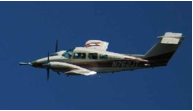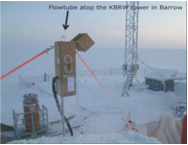Bromex
BRomine, Ozone, and Mercury EXperiment (BROMEX)
Implication of Arctic Sea Ice Reduction on Tropospheric Bromine, Ozone, and Mercury Chemical Processes, Transport, and Distribution
Follow our adventures in Barrow, AK, from February-April 2012 via our blog at http://shepsonbromex.blogspot.com/ and visit the official BROMEX web site at https://airbornescience.jpl.nasa.gov/highlights/bromine-ozone-and-mercury-experiment-bromex
Arctic sea ice extent is rapidly decreasing with climate change (read more at http://nsidc.org/cryosphere/sotc/sea_ice.html). What impacts does this have on the atmosphere and ecosystem? We are heading to the Arctic this spring to investigate!

Airborne Measurements (NASA funding)
Prof. Paul Shepson and Department of Aviation Technology mechanic Brian Stirm will fly our group’s airplane, the Purdue Airborne Laboratory for Atmospheric Research (ALAR), a twin-engine Beechcraft Duchess from West Lafayette, IN, to Barrow, AK. ALAR will be used to examine the spatial distribution of BrO, ozone,and particles. BrO will be measured via multi axis differential optical absorption spectroscopy (MAX-DOAS) via collaboration with Prof. Ulrich Platt at the University of Heidelberg. Comparisons with satellite-based measurements (SCIAMACHY) will be an important component of BROMEX.

Ground-based Measurements (NSF funding)
NSF Postdoctoral Fellow in Polar Regions Research Dr. Kerri Pratt and graduate student Kyle Custard will conduct ground-based tropospheric measurements ~2 miles inland near the clean-air sect or of the Barrow Environmental Observatory. BrOx and ClOx will be measured by our newly developed flowtube method, and Br2, Cl2, BrCl, and BrO will be measured via chemical ionization mass spectrometry. Speciated mercury measurements will also be made in collaboration with Dr. Sandy Steffen (Environment and Climate Change Canada), Dr. Chris Moore (formerly Desert Research Institute, now at GTI Energy), and Dr. Daniel Obrist (formerly Desert Research Institute, now at University of California). In addition, we will investigate the process of halogen activation via snow chamber studies, using a variety of possible halogen sources, including samples of snow and sea ice.
You can see photos from BROMEX here.
